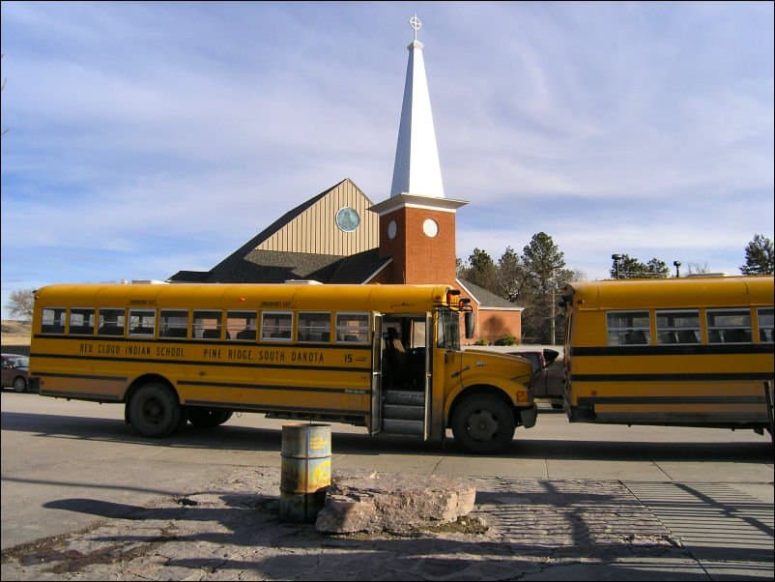“Your room is a lot smaller than it looked,” said my parents when they sat down on the chair I FaceTime them from every Sunday night. “Yeah? Well, check out this view.”
After two and a half years of FaceTiming from South Dakota to Wisconsin, my parents came to visit. We had two and a half days to see it all. Strategy: six essential tasks, hope for the best.
***
Task 1: Meet as many mentors as possible. By luck or by grace, this was surprisingly easy because both of our school’s Lakȟóta elders were in the lobby and staff lounge as my parents walked in.
“Mom, Dad, I’d like you to meet Uŋčí… that means grandmother, and like the students, I’ve felt like she’s been a wise grandmother for me these last couple years…”
Task 2: Ride along on the after-school bus route. It’s crazy looking into the rear-facing mirror to see my parents, the ones who saw me off on the bus for twelve years, sitting with my students in the grey leather seats.
To my delight, I also saw that Betty and Donna, upstanding third-graders, were fulfilling their assigned duty of bus companion for my parents: “Betty, Donna, can I ask you a favor? My parents are going to be riding the bus tomorrow, and they haven’t ridden a school bus in a long time. Would you mind sitting with them and making them feel welcome? Maybe telling them a little bit about our school and Pine Ridge?”
Task 3: Eat dinner with Jesuits. “Nope, you can’t sit there— that’s where Brother Mike always sits.”
Task 4: Chaperone Youth Pow-wow. All the students in the gym, all their dancing regalia unpacked from rolling totes, they took turns helping one another to fasten their beadwork and braid each other’s hair. The bus parked and the kids hard at work, my parents turned to me and asked, “What do we do now?” “Enjoy it. This is a privileged place to be…
Tȟéča Wačhípi Okȟólakičhiye means Youth Dancers’ Society, and all the schools on the reservation take turns hosting one each year— we host ours at the end of October. Pow-wows are an incredible chance for students to come together and to compete in the traditional Lakȟóta dances or the Lakȟóta handgames they’re playing over in that hallway— maybe we can have Talon teach you the rules later, if you want!”
Task 5: Go to mountains. “After long weeks at school, I love coming up to the Black Hills to clear my mind, to hike, to pray, to camp—Mom, you’ve never seen mountains, right? Oh, man. Ahhhh, you’ll love it.”
After an hour of quiet drive through the early rolling foothills, the question came: “Garrett, does it ever feel weird to you being the only white man in places like that? I mean, it was weird, noticing that we were the only white people in there, but yet we felt so welcomed—those other chaperones and the kids and your friend in the drum group were all so welcoming, but we couldn’t help but notice that we were outsiders there. Do you feel that a lot?”
Three hours of conversation ensued, punctuated and paused only for the passing buffalo, scenic selfies, and lunch on the rocks. Race and ethnicity, power and privilege, colonialism and the Church, Jesuits on the reservation and immigrants in our hometown, solidarity and social justice, Christ’s call and our challenges and slip-ups therein…
Even though we talk every week, we told stories on that winding drive that we had never told each other before. Summiting peaks of honesty, growth and support I never thought we could or would or even should—I didn’t even think to plan what became this deeply shared reflection.
Ironically, coming down was the hardest part, Mom backseat-driving me around the hairpin turns—“Mom, STOP. I know what I’m doing. I’ve done this with ice and snow on a bus full of children. I am a South Dakota bus driver. I can handle this.” Dad liked that.
Task 6: Go to Mass. I couldn’t imagine my parents’ visit without them staying for Sunday Mass at Sacred Heart. Praying with my parish home, meeting the rest of the choir and trying their best at the post-communion Lakota hymn; it was the perfect send-off for their long drive home.
***
Planning my parents’ visit forced me to ask: what makes this home? How can I invite them into it? Home is a moving target, but I cobbled together my best itinerary based on the who’s, what’s and where’s that matter.
I tried to show my parents all the things that made this home, but they found it themselves. We completed all my tasks, but it wasn’t until they started asking questions that we really got it:
Yes, home is the people I live for and live with.
Yes, it is the places I go to teach and rest and hike.
But, home is also the big questions I live as a privileged white man on the reservation, trying to answer my Christian call to kinship— even and especially in places where Church history hurts and my skin color represents violence.
We had two and a half days to see the life of two and a half years. We didn’t waste a moment. From my friends and favorite places all the way to my challenges and insecurities, I knew they got it when the questions came out.
They had a lot to talk about on the sixteen hour trip home.
And our FaceTime conversations have been easier since– no more backstory needed.
-//-
The cover image, from Flickr user Raymond Bucko SJ, can be found here.


